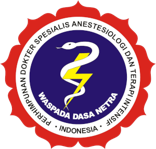Anesthesia Management at Postpartum et causa Atonic Uteri Bleeding in P3A0H3 Post SCTP Outside Dr. Moewardi Hospital
Abstract
Postpartum hemorrhage remains the leading cause of maternal mortality and morbidity worldwide, happens more in developing countries with an estimated mortality rate of 140,000 per year or one maternal death every four minutes
To understand anesthesia management at postpartum et causa atonic uteri bleeding outside Dr. Moewardi hospital
In this case reported 25 years old patient was admitted to the emergency room at Dr. Moewardi Hospital Surakarta, on the 28/11/2019 at 15.30 WIB, sent by Waras Hospital Wiris Boyolali. On examination found the patient in a state of weakness, apathy awareness and blood pressure 90/60, heart rate 130, respiration rate 22, conjunctival anemic and palpable contractions of soft uterine contractions. The patient's condition is in accordance with the manifestation of grade III blood loss. The anesthesiology diagnosis is a 25-year-old woman with Postpartum hemorrhage et causa Atonic Bleeding of Uterine on P3A0H3 post SCTP Outside Dr. Moewardi Hospital + Hypovolemic Shock pro Emergency Laparotomy until Total Abdominal Hysterectomy with Physical Status ASA IVE Plan with RSI general anesthesia Control.
Intraoperative Management of anesthesia uses RSI's general anesthesia technique to control hemodynamics and uses anesthesia drugs that do not worsen the patient's condition. At the time of surgery, we did the transfusion because there was a significant amount of bleeding during the procedure and was categorized as Class IV bleeding.
Anesthesia care of patients with postpartum hemorrhage extends from the antenatal period to the postpartum period. Optimal postpartum hemorrhage management occurs when nurses, obstetricians and anesthesiologists recognize early the potential for excessive bleeding and trigger a 'major obstetric hemorrhage protocol' that describes specific tasks for each team player and the algorithm that must be followed according to etiology, circumstances and time during labor.
Keywords
Full Text:
PDFReferences
Abir G, Mhyre J. Maternal mortality and the role of the obstetric anesthesiologist. Best Pract Res Clin Anaesthesiol [Internet]. 2017;31(1):91–105. Available from: http://dx.doi.org/ 10.1016/j.bpa.2017.01.005 5. Blitz MJ, Yukhayev A, Pachtman SL, Reisner J, Moses D, Sison CP, et al. Twin pregnancy and risk of postpartum hemorrhage. J Matern Neonatal Med [Internet]. 2020;33(22):3740–5. Available from: https://doi.org/10.1080/14767058.2019.1583736 2. Di Florio A, Jones L, Forty L, Gordon-Smith K, Robertson Blackmore E, Heron J, et al. Mood disorders and parity - A clue to the aetiology of the postpartum trigger. J Affect Disord. 2014;152–154(1):334–9. 3. Dept. of Reproductive Health and Research W. WHO recommendations for the prevention and treatment of postpartum haemorrhage. World Health Organization. 2012. 7. Fardelmann KL, Alian AA. Anesthesia for Obstetric Disasters. Anesthesiol Clin [Internet]. 2020;38(1):85–105. Available from: https://doi.org/ 10.1016/j.anclin.2019.10.005 4. Filho EAR, Costa ML, Cecatti JG, Parpinelli MA, Haddad SM, Pacagnella RC, et al. Severe maternal morbidity and nearmiss due to postpartum hemorrhage in a national multicenter surveillance study. Int J Gynecol Obstet [Internet]. 2015;128(2):131–6. Available from: http://dx.doi.org/ 10.1016/j.ijgo.2014.08.023 8. Kacmar RM, Mhyre JM, Scavone BM, Fuller AJ, Toledo P. The use of postpartum hemorrhage protocols in United States Academic obstetric anesthesia units. Anesth Analg. 2014;119(4):906–10. 10. Palareti G, Legnani C, Cosmi B, Antonucci E, Erba N, Poli D, et al. Comparison between different D-Dimer cutoff values to assess the individual risk of recurrent venous thromboembolism: Analysis of results obtained in the DULCIS study. Int J Lab Hematol. 2016;38(1):42–9. 11. Pantoja T, Abalos E, Chapman E, Vera C, Serrano VP. Oxytocin for preventing postpartum haemorrhage (PPH) in non-facility birth settings. Cochrane Database Syst Rev. 2015;2015(2). 6. Reale SC, Easter SR, Xu X, Bateman BT, Farber MK. Trends in postpartum hemorrhage in the United States from 2010 to 2014. Anesth Analg. 2020;XXX(Xxx):E119–22. 9. Ring L, Landau R. Postpartum hemorrhage: Anesthesia management. Semin Perinatol [Internet]. 2019;43(1):35–43. Available from: https://doi.org/10.1053/j.semperi.2018.11.007 13. Skolnik S, Ioscovich A, Eidelman LA, Davis A, Shmueli A, Aviram A, et al. Anesthetic management of amniotic fluid embolism -- a multi-center, retrospective, cohort study. J Matern Neonatal Med [Internet]. 2019;32(8):1262–6. Available from: https://doi.org/10.1080/14767058.2017.1404024 12. Wagner JL, White RS, Mauer EA, Pryor KO, Kjaer K. Impact of anesthesiologist’s fellowship status on the risk of general anesthesia for unplanned cesarean delivery. Acta Anaesthesiol Scand. 2019;63(6):769–74.
Refbacks
- There are currently no refbacks.








